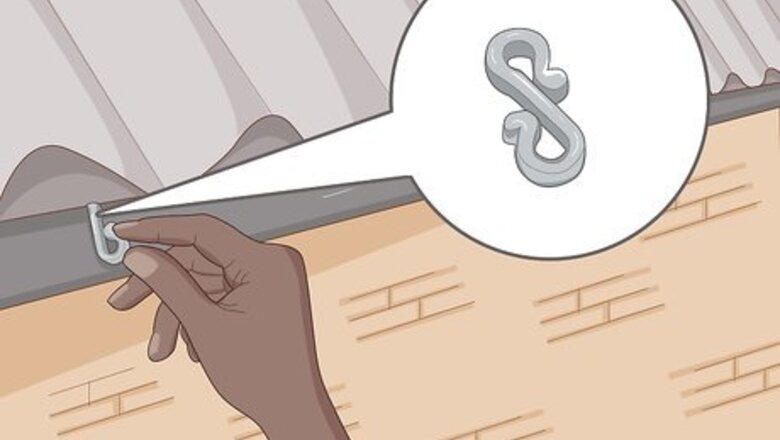
views
Hanging Lights with Hooks or Clips
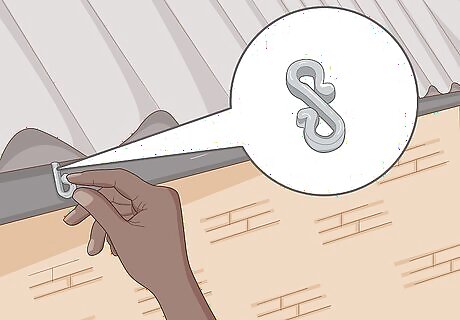
Choose gutter hooks to quickly hang lights along your gutters. Purchase S-shaped gutter hooks at the home improvement store, and hang them up by pressing the top part of the S into the gutter, with the rest of the hook resting on the front. When you’re ready to hang the lights, simply use the bottom part of the S as a hook and string the wire of the lights into each hook. Gutter hooks are inexpensive and easy to put up because they’re made of a bendable plastic. However, they can sometimes slide along the gutter since they aren’t fastened in one place.
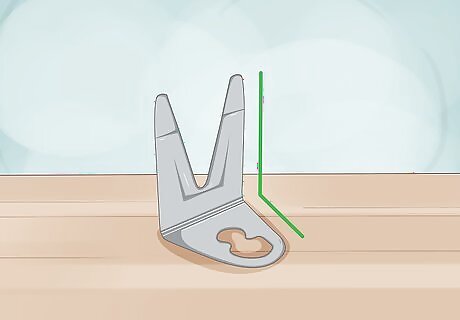
Opt for shingle tabs to position the lights on top of your roof. Shingle tabs are L-shaped with 2 prongs on one side and a small hole on the top. Slide the prongs under a shingle, and leave the side with the whole sticking up into the air. To position the lights, slide a bulb into the hole to hold it in place. The size of the hole on the tab will normally be large enough to accommodate either C7 or C9 bulbs, which are the 2 most common types of Christmas lights.
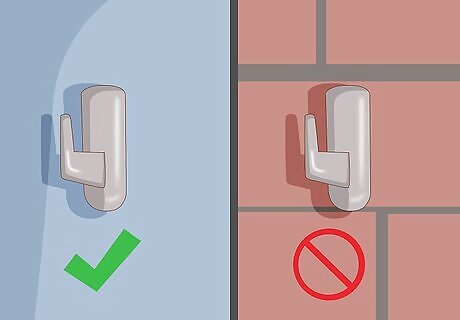
Use adhesive clips or hooks if you have siding or other smooth surfaces. To position these plastic clips, peel the protective paper off of the back and hold the sticky side onto the surface. Then, snap the base of one of the bulbs into the clip to hold it into place. Adhesive clips won’t work on textured surfaces like concrete, brick, or stucco. The weight of the lights may cause them to fall off.
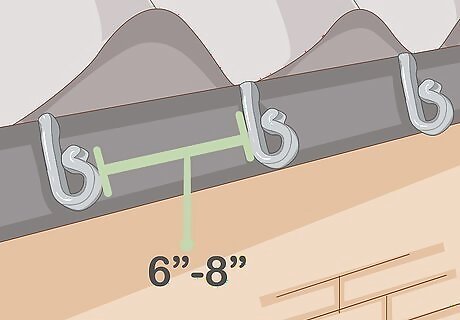
Leave 6–8 in (15–20 cm) of space between each hook or clip. Most bulbs are spaced a few inches apart, and you should have 1 hook or clip for every 1-2 bulbs. This will prevent you from using more clips than necessary and make your light display look cleaner. Spacing your bulbs farther apart allows the light from the bulbs to spread, creating a more inviting display.
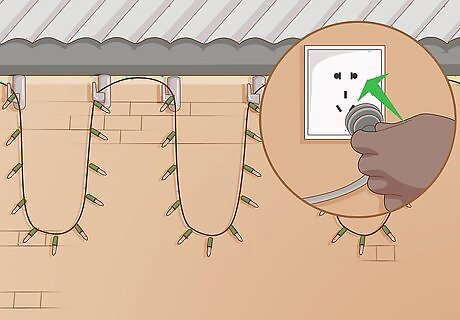
Place the male end of the strand near the power outlet. Start stringing the lights working from the outlet, wherever that might be on the outside of your house. If you don’t want to plug the lights directly into the outlet, use an outdoor extension cord to make your light strands longer. Remember to plug the strand of lights into the extension cord before you begin to string them along the roof. Then, when you’re finished hanging the lights, you can simply plug in the extension cord and admire your work.
Using Hot Glue on Brick, Concrete, and Stucco

Plug in a hot glue gun and let it heat up. Select a large glue gun for hanging the lights, and pick glue that’s safe for outdoor use. Load the glue gun and plug it in with an extension cord so you can walk around with the glue. Wait 5-10 minutes for the glue to heat up in the gun. Be careful while the glue gun is heating up. Sometimes, glue can leak out of the front of the gun, and if it gets on your skin, it can cause burns. Hot glue isn’t safe for stucco applied over styrofoam. If you’re not sure, tap lightly on the stucco surface to see if there’s a hollow sound, which means that you have styrofoam under your stucco.

Use a strand with the bulbs unscrewed from the sockets. It’s easier to use the glue gun to hang the wiring when there are no bulbs in the strand. Find a spool of bulbless lights at the home improvement store, and then purchase bulbs in whatever color and shape you prefer. If you leave the bulbs in, you might get glue on the bulbs while you’re hanging them, which can cause the lights to look dim.

Apply a pea-sized bead of glue to the side of the socket opposite the clip. Take one of the empty sockets in your hand, and find the clip on the side of the socket for releasing the bulb. Twist the socket to the opposite side, and put the glue directly on the side of the socket so you can attack it to brick, concrete, or stucco walls. For every socket, you’ll apply the glue and put it on the wall before moving onto the next socket. Don’t wait for the glue to dry before you attach it to the wall.
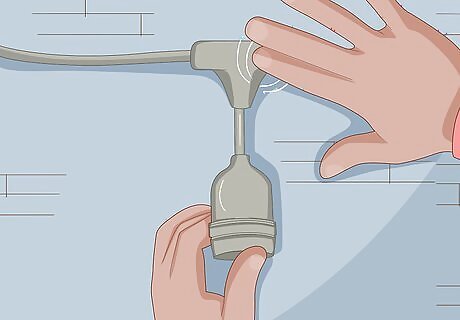
Press the light socket onto the surface and hold it for 10 seconds. As soon as you apply the glue, press that side of the socket onto the wall where you want the light to be. Make sure the socket is facing up or down, or tilted to either side to ensure that the bulb will be in the right position for your display. The orientation of the socket will depend on your personal preference. Some people prefer to have all of the bulbs facing one direction, while others light to position them randomly. If you begin to let go of the socket and it starts to slide down the wall, the glue isn’t dry. Hold it in place until the glue is firm.
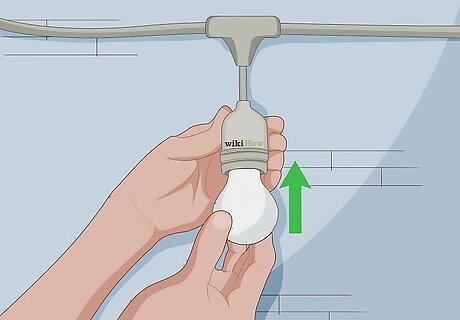
Screw in the bulbs once you have all of the sockets glued in place. Once you have all of the sockets positioned, carefully add the bulbs. Be sure not to scratch them against the wall as you put them into the sockets. Some bulbs will screw in like a regular light bulb, while other mini-lights might will snap into place in the socket. If you’re using multi-colored bulbs, you may want to organize them in a color pattern to avoid having too many bulbs of the same color next to each other.
Draping Lights for Accents
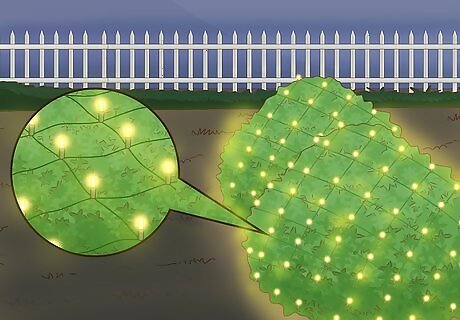
Opt for net lights to easily cover smaller bushes. Net lights are convenient for quick decorations. Plug the lights into the outlet or extension cord, and then position the square over the top of the shrub. Pull the corners of the netting down to the bottom of the shrub, and tuck some of the lights into the foliage for a more natural look. While net lights are simple to put up, it’s also easy to tell that someone used net lights for their bushes. If you want a more natural or random design, net lighting might not be the best option.
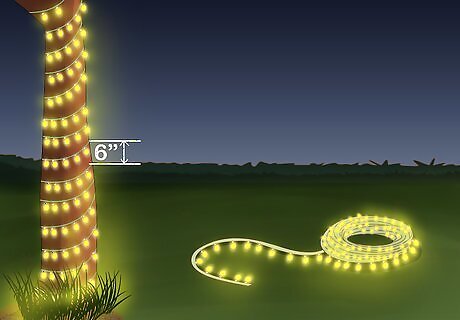
Wrap lights around the trunk of a tall tree to light it without a ladder. Use an extension cord to run the lights to the tree, and then wrap the lights around the tree trunk up until you reach the first branch, leaving 6 inches (15 cm) of space in between the strands of lights. Then, wrap the lights back down to the bottom of the trunk, passing through the middle of the space between the strands. Be sure to wrap the lights tightly to hold them in place. If you’re worried about the lights slipping down, use hot glue on the trunk of the tree to hold up some of the lights.
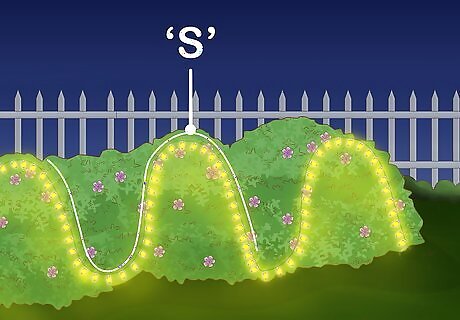
Create an “S” design over the front of the shrubs to make a random pattern. Plug in a strand of mini-lights and start on the closest side of one bush. Snake the lights through the foliage in a winding shape from the bottom of the shrub to the top, only covering the front and some of the top of the shrub. This lighting technique gives the effect of randomly dispersed lights throughout the shrubs. Be sure to work with the strands plugged in, since the lights can short circuit if they’re older. If the bulbs go dark as you’re hanging the lights, discard the strand and purchase a replacement strand.
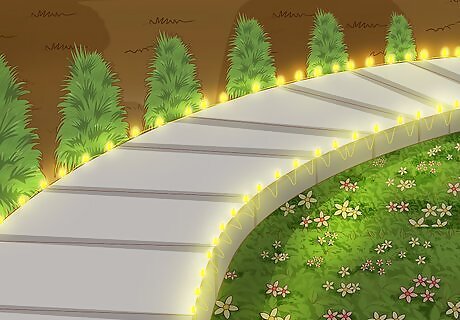
Arrange lights in strips along the side of your driveway and walkways. Try lining your driveway or walkway with small LED lights by laying them along the ground. If you’re worried about them moving, use hot glue to hold them in place, and utilize extension cords to make sure you don’t run out of lights. Be careful as you’re walking along these walkways during the holidays. If you step on one of the bulbs, or drive over a bulb, this can cause the entire strand to go dark!



















Comments
0 comment